MARKET OVERVIEW
Modern architectural trends, especially the way it has shaped up peoples' outdoor decks, residential, or commercial through the influences from the global market of bamboo decking and its industry. A change towards sustainability compels this sector to change according to new technologies, consumer demands, and environmental concerns. Looking at a little more depth, material benefits, market expansion, and deeper cultural preferences on bamboo decking show a greater complexity where supply chains interact with durability.
Bamboo is very resilient, withstanding heavy wear and tear, is almost as stable as steel, and is still the choice for environmentally conscious people. Though, as production volumes increase, the industry is expected to deal with issues like land use, emissions from processing, and resource consumption. Conventional hardwoods are taken through numerous treatment processes to prevent moisture damage, pests, and UV degradation, all of which significantly affect its longevity in various climates.
Where as Engineered bamboo product has more strength, the whole process of manufacture includes adhesives and preservatives that generate doubts about their environmental impact. International trade complexities also affect the Global Bamboo Decking market. The sourcing of quality raw material relies on regional regulations for harvesting, transportation logistics, and export policies.
Countries like China, Vietnam, and Indonesia, having large bamboo reserves, are responsible for fulfilling most of the world's demand. However, different grading standards in various countries make the product quality inconsistent. Manufacturers and distributors have to struggle with certification requirements to bring their products to the industry's benchmark. Consumer preferences play a significant role in the market trend.
Though sustainability is a strong marketing factor, the aesthetic appeal, maintenance friendliness, and easy installation are considered by the buyer. Climate also plays a vital role when selecting the bamboo deck as humid regions require better moisture resistance, while dry areas focus more on UV stability. Architects and landscape designers have begun to include bamboo in urban planning for boardwalks, pool decks, and public spaces.
The lightweight nature of the material allows for innovative structural applications, which means that it goes beyond traditional home decking. Beyond production and design, the Global Bamboo Decking market faces regulatory issues. International environmental policies, such as the European Union Timber Regulation (EUTR) and the Lacey Act in the United States, necessitate strict transparency in the supply chain.
These laws prevent illegal logging and promote responsible sourcing, but they also impose additional costs of certification and documentation. Companies which do not comply with these standards risk losing access to key markets, so alignment with regulations becomes a strategic imperative. Technological advancements are constantly redefining how bamboo decking is produced and maintained. Water resistance and UV protection treatments will be improved to increase the life of the material. Bio-based adhesives will be researched in order to replace synthetic compounds used in the production process, which will make it more environmentally friendly.
Digital tools, including AI-driven quality assessment and blockchain-based supply chain tracking, may also increase efficiency and accountability across the industry. The future Global Bamboo Decking market will present changes in customer behavior, policies, and technological advancements in material. Sustainability as a core consideration will ensure performance and affordability balances the ecological responsiveness of the direction of the industry. Bamboo decking will continue to redefine outdoor living spaces, such as urban and private homes.
Global Bamboo Decking market is estimated to reach $10,758.94 Million by 2032; growing at a CAGR of 3.6% from 2025 to 2032.
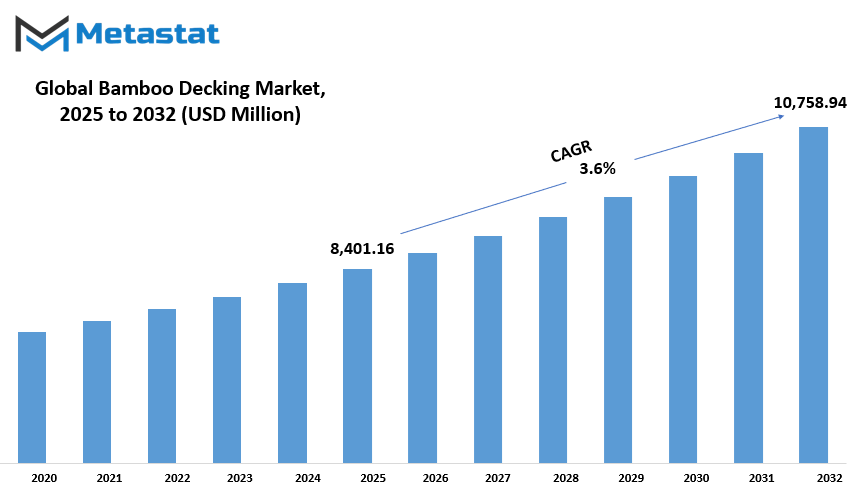
GROWTH FACTORS
The global bamboo decking market has experienced continuous growth over time, mainly attributed to the demand for sustainable, and therefore ecological, building materials. Along with the above factors, today, consciousness in all countries regarding saving the environment has increased, as a person contemplates opting for alternatives over wood and synthetic decking that are harmful to the environment.
As opposed to bamboo, it is a renewable resource and thus much more eco-friendly. Its other significant feature that adds to its attraction is sustainability, as it grows pretty fast without necessitating much water or chemicals. Thus, bamboo became the perfect option for the construction of an eco-friendly house and building.
Beyond sustainability, bamboo decking also grew in popularity as people took on more outdoor living space and landscaping projects. People are spending more and more on their outdoor places, creating a space to relax, entertain, and even garden. Bamboo, being beautiful and having a natural appearance, fits perfectly in the context in such spaces and gives a modern look yet an organic feel to the patio, deck, and garden. This will be upheld as people continue embracing outdoor living as an extension of their homes.
There is still an apparent drawback with regard to bamboo decking. These become susceptible to damage by moisture or insects, as these may damage if not appropriately treated. It takes water inside; it will result in issues related to warping, splitting, or even rotten after several periods. On top of this, bamboo may harbor termites. This damages the structure of decking without appropriate care or treatment for the materials used.
Perhaps the most critical challenge related to the growth of the bamboo decking market is that it is relatively more costly than the traditional wood decking materials. Bamboo, being sustainable, thus naturally becomes more expensive for a consumer to buy and install over time, especially considering the treatment processes involved in making it durable. This cost difference may act as a deterrent toward some consumers making a choice for bamboo decking, particularly from more price-sensitive markets.
Despite these challenges, there are opportunities in the bamboo decking market, and some developments are very promising. Advances have been made over the last year in treating the bamboo to add strength and moisture resistance to it. With enhancements to its resilience against moisture and insects and better durability in different elements, future innovations might ensure that bamboo decking has a higher opportunity to penetrate larger markets. Further on with these improvements in technology, bamboo decking is poised to be on an even wider market for both eco-conscious home owners and builders.
MARKET SEGMENTATION
By Type
Global bamboo decking market is booming, and this market has been quite in vogue over the past years with a wide range of bamboo decking products surfacing that cater to different needs of customers. One of the prime products within this market is solid bamboo decking valued at about $3,096.81 million. Strong reasons for the huge boom in the popularity of the product, which includes durability, sustainability, and aesthetics. Solid bamboo decking is manufactured from natural bamboo, which is processed into planks for use as outdoor flooring. This product has immense demand due to the greater interest in sustainable and eco-friendly building materials.
The other significant market segment for bamboo decking is engineered bamboo decking. The manufacturing process of such decking involves bonding together multiple layers of bamboo with adhesives or other bonding materials, and the resulting decking produces a product that is both strong and flexible. This kind of decking is widely used where more strength and moisture resistance are needed, like coastal or high-humidity regions. The engineered option affords much wider latitude in the design and application of bamboo decking, so it is widely used for many applications outside.
Yet another significant market segment is strand woven bamboo decking. In this case, bamboo fibers are compressed under high pressure to create a harder and denser material than plain old bamboo. Because of its high strength, strand woven bamboo decking is best used in places that have a heavy beating pattern or areas that are frequently exposed to extreme weather conditions. The strand woven bamboo decking acquired a reputation for having the utmost durability and resisting wear when subjected to this unique manufacturing process.
The last is the other types of bamboo decking that now gain more market attention. One is bamboo-composite decking, a blend of bamboo fibers with plastic or other materials, and a myriad of other hybrid products that mix bamboo with some other natural material to enhance strength and resistance to weather conditions. As consumers demand more eco-friendly and durable materials for outdoor spaces, these alternative options are gaining popularity.
The bamboo decking market will continue to build as more individuals become attracted to sustainable building practices and seek materials that are both functional and responsible. Because of the different types of bamboo deckings, homeowners and builders are presented with an abundance of choices to create exquisite durable spaces outdoors. The market is likely to experience even more innovation and expansion as companies develop new products for an increasingly environmentally-conscious consumer base.
By Application
There is rapid growth on a global scale in bamboo decking, with eco-friendly building material growing in popularity. Sustainable bamboo-one of the options known for its strength and durability-is also gaining acceptance across residential and commercial applications. Now, as issues related to environment are increasing the population is seeking bamboos as alternative renewable materials.
In the house sector, outdoor decking is greatly used in house patios, gardens, and balcony spaces. Home owners like its original look, making it suitable for lots of design alternatives. Bamboo is able to resist almost all kinds of weather conditions which make it practically ideal for being used in any outdoor environment. In addition to this, minimal environmental impact drives the interest for people who can minimize their carbon footprint while beautifying their homes.
On the other hand, the commercial sector is also getting into bamboo decking. Hotels, resorts, restaurants, and office buildings are receiving bamboo for their outdoor spaces. This material is not only cost-effective but also gives a contemporary, though sustainability-conscious image to businesses that are keen on having such customers. Bamboo is highly versatile and can be applied in different forms of commercial activities, such as walkways or simply a decorative outdoor space.
Ambitious numbers are being projected for domestic and commercial market bamboo decks. Increased awareness of the benefits of green products by consumers and businesses alike will spur continued demand for bamboo decking. Concerns over the environment and sustainability, and efforts worldwide to reduce dependency on non-renewable energy, will continue to fuel that market growth in bamboo decking.
With such attributes in residential and commercial properties, the market of bamboo decking has vast growth ahead of it. Beauty and durability merged with environmental consciousness is what is increasingly becoming popular across different kinds of properties when talking about bamboo as a choice for decking. Therefore, while it continues to expand, it would not be too long before other benefits come up that might be derived by consumers and businesses alike in using this form of decking.
By Distribution Channel
This global market for bamboo decking is becoming popular with increased demand in construction for materials which are considered environment-friendly. This bamboo material has gained its ground in recent years due to durability and as a more eco-friendly option to wooden forms. This interest in bamboo decking is not only from residential but also from commercial construction projects, where the concern for slight environmental impacts through the material used is at the forefront of the requirements.
The market for bamboo decking is segmented into multiple distribution channels that are critical in making these products available to customers. These are classified as online retail, offline retail, and traditional retail. Demand has recently increased in online retail, attributed to the fact that consumers would rather shop from their homes. Many have been attracted to online retail because of the convenience of browsing through different products and comparing prices. In addition, most online sites usually give more elaborate descriptions of products, reviews, and ratings, which guide the consumers in making informed purchasing decisions.
Offline retail and traditional retail channels continue to play a huge role in the market. Physical stores give customers the chance to see and touch the products before buying. This is especially true in decking materials, as the consumer wants assurance of the quality and texture of the bamboo before making a commitment to a project. Many consumers still prefer in-person shopping experiences where they can ask questions and get recommendations from knowledgeable staff.
Demand for bamboo decking both on- and off-line will grow as it becomes more convenient for consumers to seek and buy in this channel compared to the traditional platform. The threat of competition is high because of the presence of multiple manufacturers/suppliers who acknowledge the significance of such channels in reaching the target distribution of their products.
As the popularity of bamboo decking continues to grow, it can be well noted that the market will only benefit from a mix of both online and offline retailing. That way, the varied needs and preferences of consumers will be met best. The growth clearly demonstrates not only the increased awareness of building with sustainable materials but also the increasing willingness of consumers to invest in environmentally friendly solutions for their homes and businesses.
|
Forecast Period |
2025-2032 |
|
Market Size in 2025 |
$8,401.16 million |
|
Market Size by 2032 |
$10,758.94 Million |
|
Growth Rate from 2024 to 2031 |
3.6% |
|
Base Year |
2024 |
|
Regions Covered |
North America, Europe, Asia-Pacific, South America, Middle East & Africa |
REGIONAL ANALYSIS
The global Bamboo Decking market is divided into several regions. These regions include North America, Europe, Asia-Pacific, South America, and the Middle East & Africa. The sub-divisions are carried out further with respect to the countries or the sub-regions for better clarity in understanding market dynamics and trends.
The North American market is further segmented into three main countries: the United States, Canada, and Mexico. All these countries have a significant role in demand and growth of bamboo decking. The U.S. often takes the biggest market share due to its demand for sustainable and eco-friendly building materials. The other two countries also add to the market, though demand may differ due to regional preferences and construction trends.
Europe, however is broken into countries. Amongst the major ones include United Kingdom, Germany, France, Italy, and the rest of Europe. Bamboo decking has emerged to be the biggest market for both the UK and Germany. They have a significant concern over the adoption of green building materials in the construction process. The rest are France and Italy. Although demand for this commodity has grown here, it's not as huge as it is in the UK and Germany. Other European countries contribute to the overall market but tend to have a smaller share.
Asia-Pacific is the other major market for bamboo decking. This market can be divided into countries such as India, China, Japan, South Korea, and the rest of Asia-Pacific. The biggest market in this region is China because of its significant production capacity and high domestic demand for bamboo products. Other big participants in this region are Japan and South Korea, as demand for eco-friendly materials in construction has risen. India, with infrastructural growth as well, is witnessing an upsurge in bamboo decking while other countries in the same region boost the overall market growth.
South America comprises of countries like Brazil, Argentina, and the rest of the South American region. Being the largest country in South America, Brazil spearheads the demand for bamboo decking since it follows sustainable construction practice. Argentina, along with the other South American nations, has slowly started following bamboo decking in its green building policies.
Finally, Middle East & Africa is segmented into GCC countries, Egypt, South Africa, and others. GCC countries like Saudi Arabia and the UAE are key markets because they are investing in modern construction and infrastructure projects. Egypt and South Africa also contribute to the market, as awareness of sustainable building materials is increasing. The rest of the region is though smaller in size but in growth in its bamboo decking.
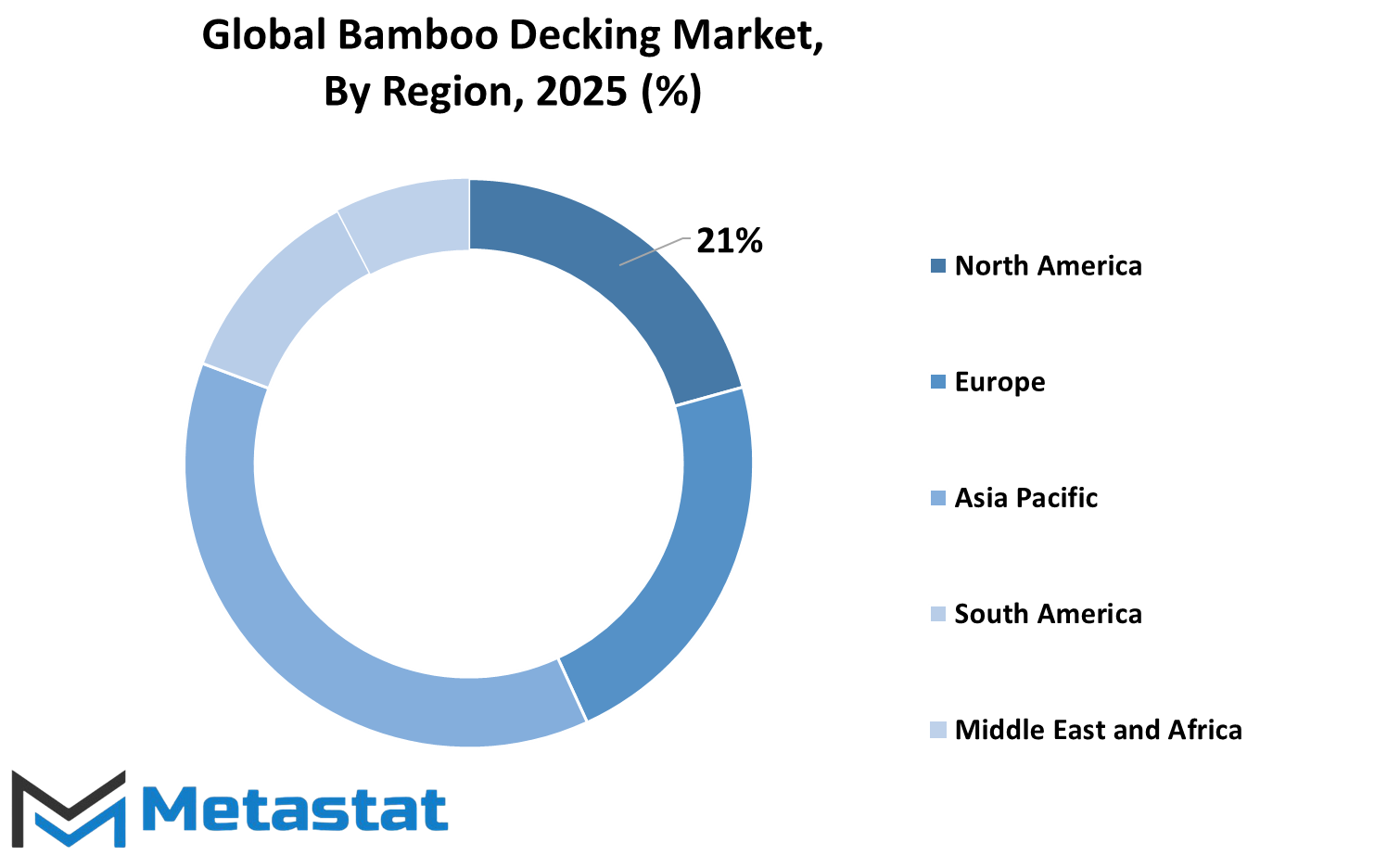
COMPETITIVE PLAYERS
The market of Bamboo Decking is showing gradual growth as most of the big players have played a major role in contributing to the industry. Companies such as Bamboo Australia, Bamboo Your World BV, and Cali Bamboo have been among some of the other big names which expanded their business according to the growth in demand of sustainable and eco-friendly alternatives in decking markets. Some of the known brands in the industry that have been recognized with high reputations in quality are offering quality products for residential and commercial purposes.
Another popular name in Bamboo Decking market is Dasso Group. Dasso Group is widely known for innovation while producing bamboo decking material. This material, along with its sustainability, makes the bamboo an up-coming decking material these days. Similarly, Eco Bamboo & Wood and Forever Bamboo have established themselves as market leaders by providing a wide range of bamboo decking options that cater to different aesthetic preferences and functional needs.
Apart from these companies, there are several players in China, including Jiangxi Feiyu, Jiangxi Shanyou, and Kangda, which are significant in the global Bamboo Decking market. These companies have taken advantage of the cost-effective production of bamboo decking materials, further expanding the accessibility of bamboo products worldwide. Kanger Group and MOSO International BV are also notable, as they have been at the forefront of promoting bamboo's environmental benefits while continuing to innovate in the production of decking solutions.
Other companies such as Sinohcon, Tengda, and Teragren Bamboo are dedicated to producing high-quality bamboo decking that meets international standards. Company commitment to sustainability and the use of cutting-edge technology have maintained competitive advantage. Some of the other companies include Tianzhen Bamboo and US Floors Inc. that have excelled in this industry through provision of premium bamboo decking products for different market segments.
Xiamen Eisho Industrial Co., Ltd. and Yoyu are other important contributors to this growing Bamboo Decking market. These companies offered products specifically focusing on the requirements that customers seek by opting for durable and eco-friendly outdoor flooring. Considering the presence of numerous brands competing in the marketplace, the diversity of the Bamboo Decking business is becoming even greater while providing customers a wide choice option for choosing that perfect decking product.
Overall, the Bamboo Decking market is thriving with numerous players actively involved in driving growth and innovation. Their focus on sustainability, product quality, and consumer satisfaction will continue to shape the industry's future in the coming years.
Bamboo Decking Market Key Segments:
By Type
- Solid Bamboo Decking
- Engineered Bamboo Decking
- Strand Woven Bamboo Decking
- Other
By Application
- Residential
- Commercial
By Distribution Channel
- Online Retail
- Offline Retail
Key Global Bamboo Decking Industry Players
- Bamboo Australia
- Bamboo Your World BV
- Cali Bamboo
- Dasso Group
- Eco Bamboo & Wood
- Forever Bamboo
- Jiangxi Feiyu
- Jiangxi Shanyou
- Kangda
- Kanger Group
- MOSO International BV
- Sinohcon
- Tengda
- Teragren Bamboo
- Tianzhen Bamboo
WHAT REPORT PROVIDES
- Full in-depth analysis of the parent Industry
- Important changes in market and its dynamics
- Segmentation details of the market
- Former, on-going, and projected market analysis in terms of volume and value
- Assessment of niche industry developments
- Market share analysis
- Key strategies of major players
- Emerging segments and regional growth potential



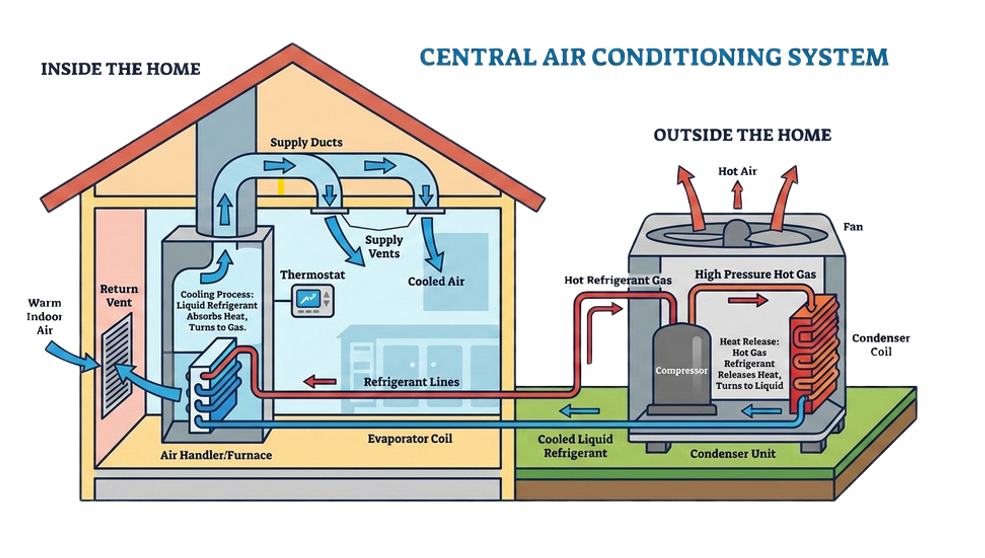
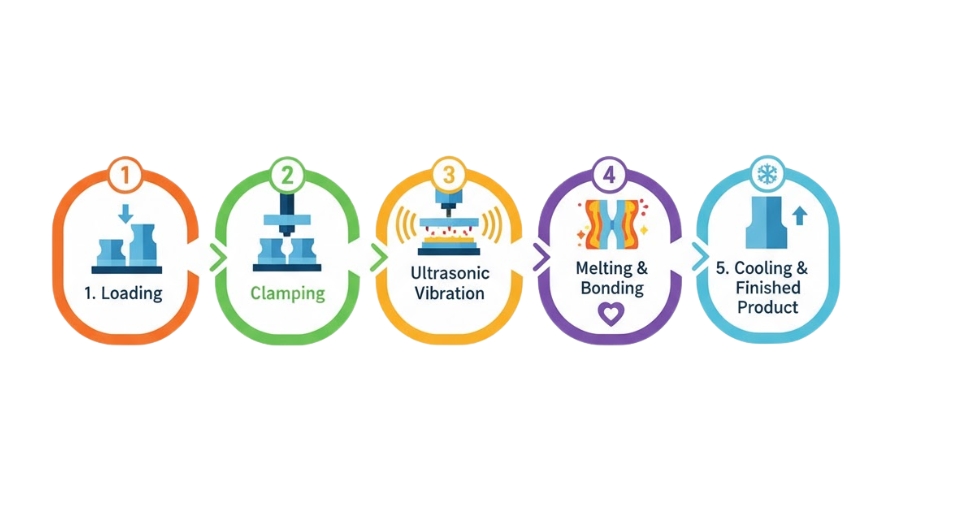
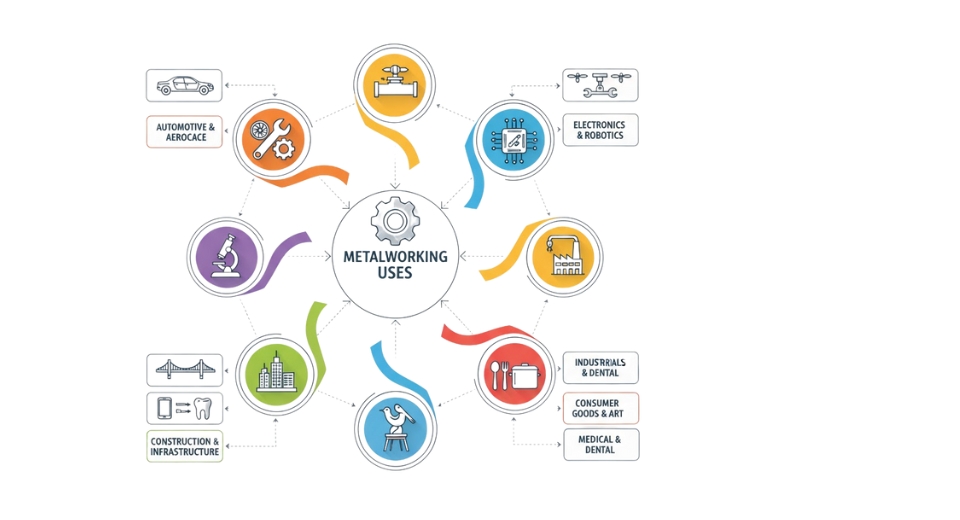
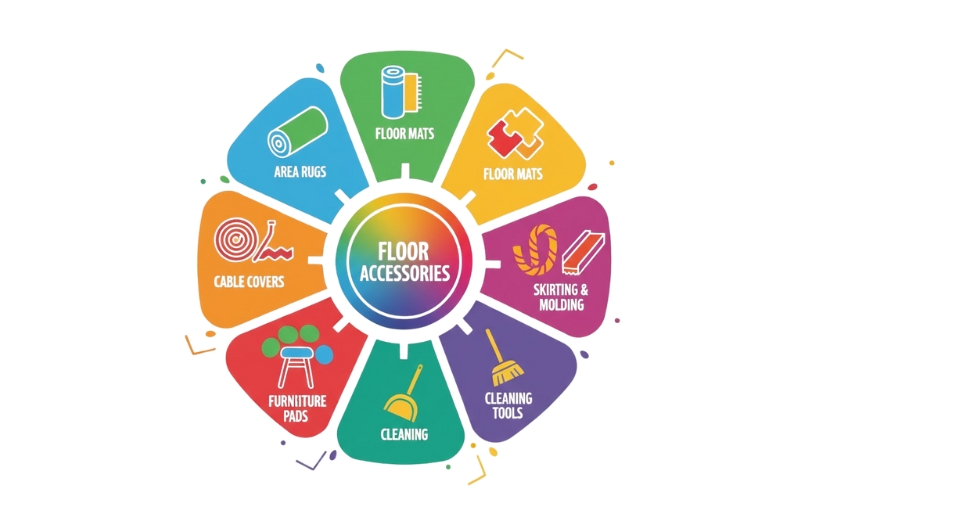

 US: +1 3023308252
US: +1 3023308252






